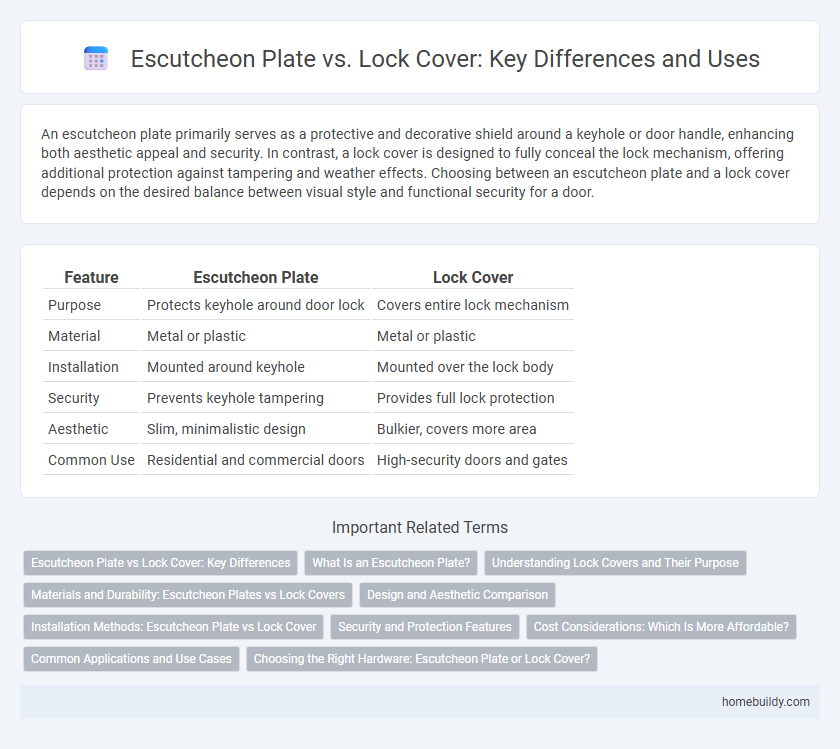An escutcheon plate primarily serves as a protective and decorative shield around a keyhole or door handle, enhancing both aesthetic appeal and security. In contrast, a lock cover is designed to fully conceal the lock mechanism, offering additional protection against tampering and weather effects. Choosing between an escutcheon plate and a lock cover depends on the desired balance between visual style and functional security for a door.
Table of Comparison
| Feature | Escutcheon Plate | Lock Cover |
|---|---|---|
| Purpose | Protects keyhole around door lock | Covers entire lock mechanism |
| Material | Metal or plastic | Metal or plastic |
| Installation | Mounted around keyhole | Mounted over the lock body |
| Security | Prevents keyhole tampering | Provides full lock protection |
| Aesthetic | Slim, minimalistic design | Bulkier, covers more area |
| Common Use | Residential and commercial doors | High-security doors and gates |
Escutcheon Plate vs Lock Cover: Key Differences
Escutcheon plates are decorative and protective metal or plastic coverings that encircle keyholes or lock cylinders, often enhancing the door's aesthetic while providing security against tampering. In contrast, lock covers are primarily functional, designed to shield the entire lock mechanism from dirt, weather, and vandalism, usually without ornamental features. The key differences lie in their purpose and design focus: escutcheon plates emphasize both style and keyhole protection, whereas lock covers concentrate on safeguarding the lock's operational components.
What Is an Escutcheon Plate?
An escutcheon plate is a protective and decorative hardware component mounted around a door lock or keyhole, designed to shield the area from wear and enhance aesthetic appeal. Unlike a lock cover, which fully encloses the lock mechanism to provide security and prevent tampering, the escutcheon plate focuses mainly on surface protection and style without obstructing key access. Materials commonly used for escutcheon plates include brass, stainless steel, and bronze, chosen for durability and corrosion resistance.
Understanding Lock Covers and Their Purpose
Lock covers serve primarily to protect the locking mechanism from dust, moisture, and tampering, enhancing the lock's durability and security. Unlike escutcheon plates, which focus on aesthetic appeal and decorative framing around keyholes, lock covers provide functional shielding that preserves lock performance. Understanding the distinction aids in selecting components that balance security needs with design preferences for door hardware.
Materials and Durability: Escutcheon Plates vs Lock Covers
Escutcheon plates are typically made from robust materials such as stainless steel, brass, or aluminum, offering excellent resistance to corrosion and wear, which enhances their durability in both indoor and outdoor settings. Lock covers often use lighter materials like plastic or thin metal, providing basic protection against dirt and dust but generally lacking the long-term corrosion resistance and strength of escutcheon plates. The superior material quality of escutcheon plates makes them more reliable for securing and protecting door lock mechanisms over extended periods.
Design and Aesthetic Comparison
Escutcheon plates offer a sleek, minimalist design that enhances door aesthetics with smooth surfaces and refined edges, creating a polished look often preferred in modern interiors. Lock covers tend to be bulkier and more utilitarian, sometimes disrupting the door's overall visual harmony due to their larger size and less intricate design. The escutcheon plate's slender profile allows it to seamlessly integrate with various door styles, providing both decorative appeal and functional protection around keyholes.
Installation Methods: Escutcheon Plate vs Lock Cover
Escutcheon plates typically require precise alignment and secure fastening with screws directly onto the door surface, ensuring a flush and decorative fit around the keyhole or lock cylinder. Lock covers, in contrast, often feature a simpler snap-on or clip-on installation designed for quick attachment and removal, providing a protective barrier over the lock mechanism without extensive hardware. Installation of escutcheon plates generally demands more tools and meticulous measurement to maintain both aesthetic appeal and functional security.
Security and Protection Features
An escutcheon plate offers enhanced security by reinforcing the area around a door lock, preventing forced entry and tampering more effectively than a standard lock cover. Its robust design typically includes hardened steel construction and anti-drill features, providing superior protection against physical attacks. Unlike basic lock covers, escutcheon plates also shield keyholes from environmental damage and unauthorized access, ensuring long-term durability and safety.
Cost Considerations: Which Is More Affordable?
Escutcheon plates generally cost less than lock covers due to their simpler design and easier installation process. While lock covers provide enhanced security features and durability, these benefits come with a higher price tag, often doubling the cost of basic escutcheon plates. For budget-conscious projects, escutcheon plates offer an affordable solution without compromising essential door hardware functionality.
Common Applications and Use Cases
Escutcheon plates are primarily used to enhance door aesthetics and protect keyholes or lock cylinders in residential and commercial settings, offering a sleek and durable finish. Lock covers, often found in industrial or high-security environments, provide extra protection against tampering and weather exposure by fully enclosing the lock mechanism. Both components ensure security but differ in function, with escutcheon plates emphasizing decorative protection and lock covers focusing on robust safety measures.
Choosing the Right Hardware: Escutcheon Plate or Lock Cover?
Choosing the right hardware between an escutcheon plate and a lock cover depends on the level of security and aesthetic appeal desired for a door. Escutcheon plates provide enhanced protection to lock cylinders, preventing tampering and drilling, while lock covers primarily serve to conceal keyholes and offer basic protection. For high-security applications, escutcheon plates are preferred, whereas lock covers suit decorative or low-risk environments.
Escutcheon plate vs Lock cover Infographic

 homebuildy.com
homebuildy.com